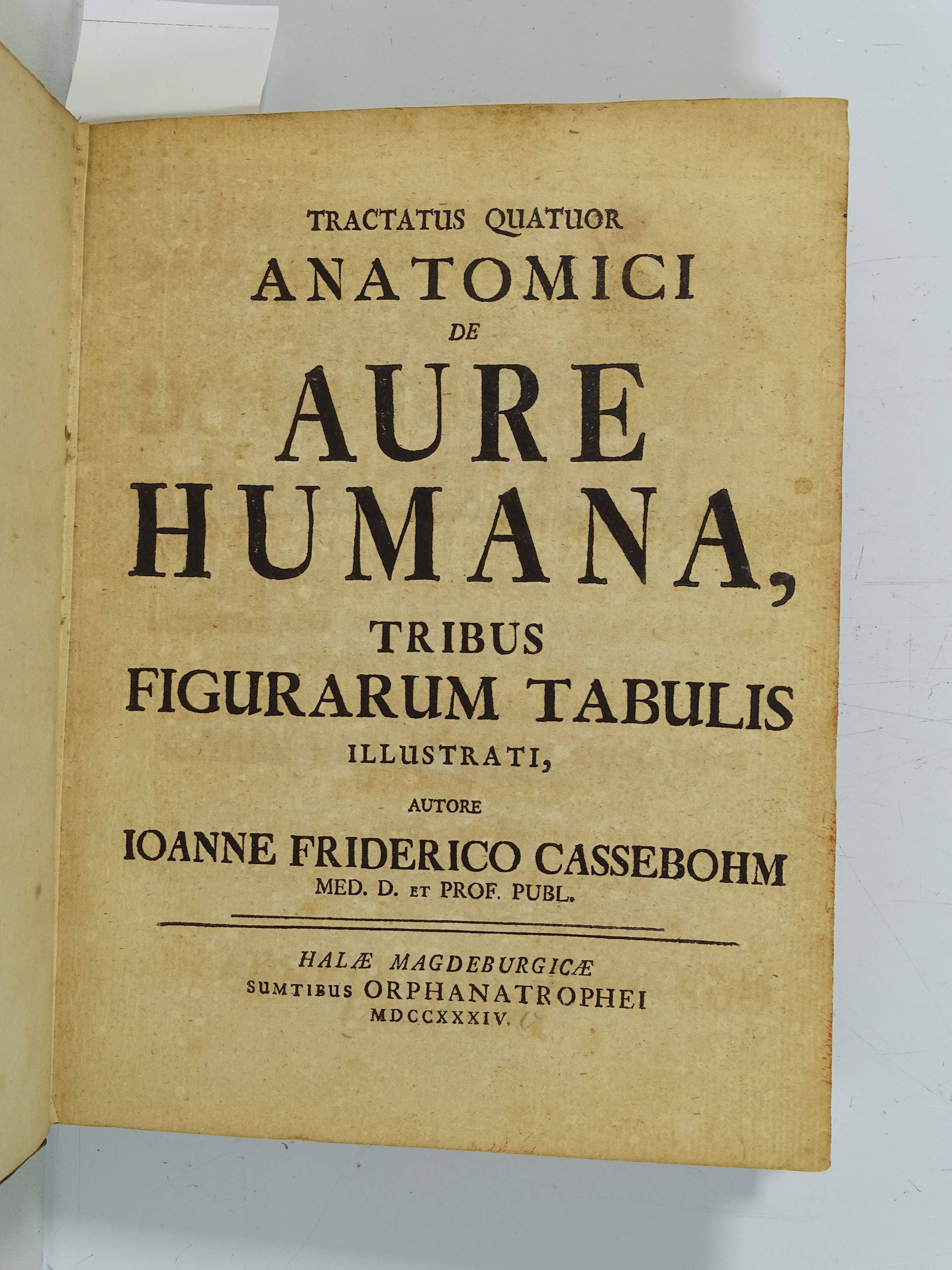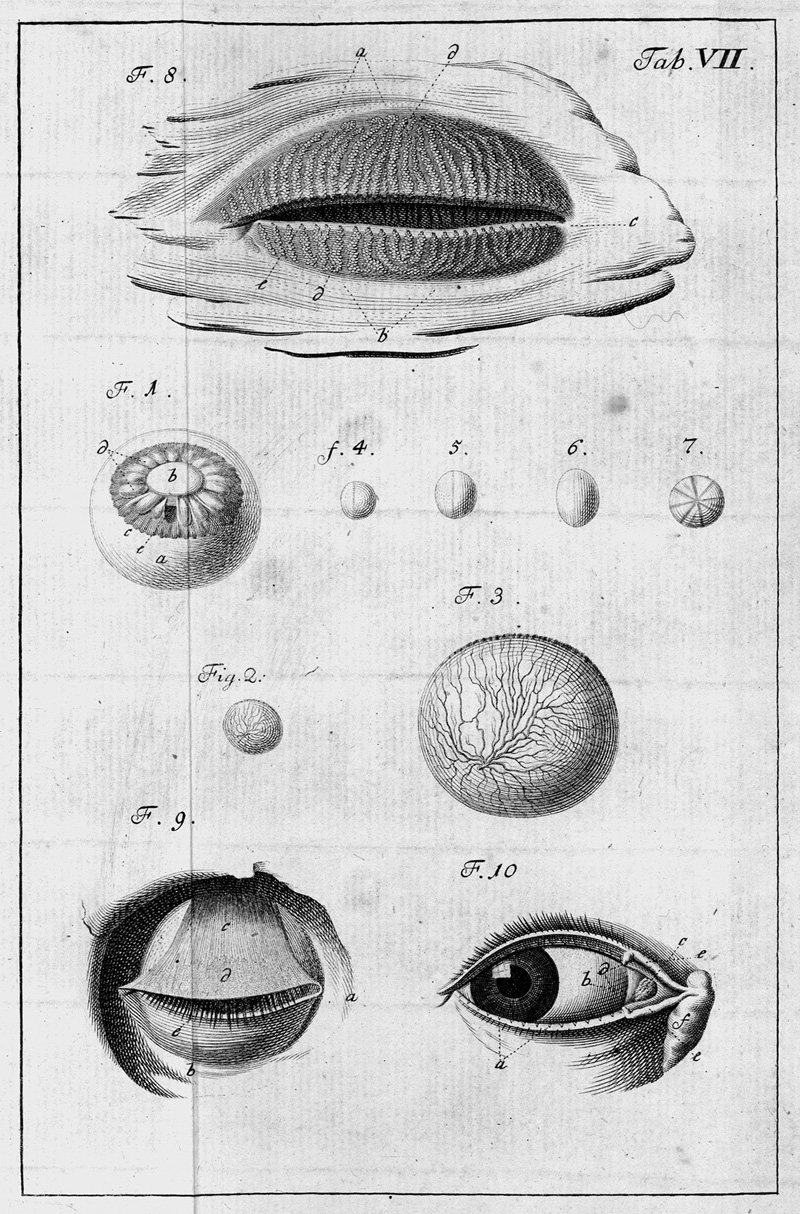Zwei medizinische "Klassiker" Cassebohm, J. F. Tractatus quatuor anatomici de aure humana [und] Tractatus quintus anatomicus de aure humana. 2 Teile in 1 Band. 6 Bl., 84 S.; 3 Bl. 64 S., 3 Bl. Mit 6 gefalteten Kupfertafeln. 20,5 x 18 cm. Halbleder d. Z. (leicht berieben und bestoßen) mit goldgeprägtem RSchild, goldgeprägtem VDeckelaufdruck "Sv. Läkare Sällskapet". Halle, Waisenhaus, 1734. Wellcome II, 309. Blake 80. Hirsch I, 678. Garrison-Morton 469.1. Eimas 848 (nur Band I). Politzer 177-179. – Erste Ausgabe dieses Klassikers der Hals-Nasen-Ohren Heilkunde. Über die Anatomie des Ohres, dem Spezialgebiet des Mediziners Johann Friedrich Cassebohm aus Halle. Diese 6 Traktate sind ein Hauptwerk der Otologie. Die von dem Studenten Petsche gezeichneten Tafeln gehören zu den besten seiner Zeit. "Johann Friedrich Cassebohm (1699-1743) was one of several eigtheenth century German anatomists who, inspired by the achievements of their Italian counterparts (Valsalva, Cotugno, Casserio et al.), made significant contributions to the study of the anatomy of the ear. His six treatises on the ear, representing the complete results of his researches, contained much new and revised information on the organ of hearing, particularly regarding the middle ear. The first five treatises deal with the temporal bone, outer ear, tympanic cavity, contents of the tympanic cavity, and the labyrinth; the sixth describes a monstrous "double ear" taken from a malformed six-month-fetus. Cassebohn's discussion of the temporal bone contained the first precise and detailed account of its structures, and he anticipated Cotugno in his knowledge of the two recesses in the labyrinth's vestibular sacs. He also gave an excellent account of the changes that the ear undergoes in the fetus, the infant and the aged. Cassebohm's studies of the embryonic ear far surpassed his predecessors, including Valsalva and Morgagni, and were themselves not surpassed until the work of Huschke and von Baer" (Garrison-Morton). – Das Titelblatt von Teil I leicht gebräunt, mit hs. sowie gestempelten Besitzvermerk, im oberen Rand des Titels mit leichten Knickspuren, sonst gutes und annähernd fleckenfreies Exemplar. – Beigebunden: Johann Gottfried Zinn. Descriptio anatomica oculi humani iconibus illustrata. 8 Bl., 272 S. Mit 7 gefalt. Kupfertafeln. Göttingen, Vandenhoeck, 1755. - Hirsch-H. VI 375. Garrison-M. 1484. Waller 10493. - Erste Ausgabe dieses klassischen Werkes der medizin. Literatur. - Hauptwerk von Johann Gottfried Zinn (1727-1759), mit dem er "seinen Namen für alle Zeiten unsterblich gemacht" hat (H.). - "Sehr eingehend beschäftigt er sich unter Anderem mit den Gefässen und Nerven der Orbita und des Bulbus, er beschreibt ferner die stärkere Linsenkrümmung bei Kindern, giebt wohl als der Erste eine nahezu richtige Darstellung der Form des Bulbus und des Corpus ciliare« (ebd.) - Zinn stammte aus Ansbach u. studierte u. a. in Göttingen bei Haller u. in Berlin. Er wurde 1753 nach Göttingen als Prof. der Med. u. Direktor des botanischen Gartens berufen. - "The illustrations in this work, engraved by Joel Paul Kaltenhofer, mark a new plateau in the graphic representation of the eye ..." (B. Coll.).
Zwei medizinische "Klassiker" Cassebohm, J. F. Tractatus quatuor anatomici de aure humana [und] Tractatus quintus anatomicus de aure humana. 2 Teile in 1 Band. 6 Bl., 84 S.; 3 Bl. 64 S., 3 Bl. Mit 6 gefalteten Kupfertafeln. 20,5 x 18 cm. Halbleder d. Z. (leicht berieben und bestoßen) mit goldgeprägtem RSchild, goldgeprägtem VDeckelaufdruck "Sv. Läkare Sällskapet". Halle, Waisenhaus, 1734. Wellcome II, 309. Blake 80. Hirsch I, 678. Garrison-Morton 469.1. Eimas 848 (nur Band I). Politzer 177-179. – Erste Ausgabe dieses Klassikers der Hals-Nasen-Ohren Heilkunde. Über die Anatomie des Ohres, dem Spezialgebiet des Mediziners Johann Friedrich Cassebohm aus Halle. Diese 6 Traktate sind ein Hauptwerk der Otologie. Die von dem Studenten Petsche gezeichneten Tafeln gehören zu den besten seiner Zeit. "Johann Friedrich Cassebohm (1699-1743) was one of several eigtheenth century German anatomists who, inspired by the achievements of their Italian counterparts (Valsalva, Cotugno, Casserio et al.), made significant contributions to the study of the anatomy of the ear. His six treatises on the ear, representing the complete results of his researches, contained much new and revised information on the organ of hearing, particularly regarding the middle ear. The first five treatises deal with the temporal bone, outer ear, tympanic cavity, contents of the tympanic cavity, and the labyrinth; the sixth describes a monstrous "double ear" taken from a malformed six-month-fetus. Cassebohn's discussion of the temporal bone contained the first precise and detailed account of its structures, and he anticipated Cotugno in his knowledge of the two recesses in the labyrinth's vestibular sacs. He also gave an excellent account of the changes that the ear undergoes in the fetus, the infant and the aged. Cassebohm's studies of the embryonic ear far surpassed his predecessors, including Valsalva and Morgagni, and were themselves not surpassed until the work of Huschke and von Baer" (Garrison-Morton). – Das Titelblatt von Teil I leicht gebräunt, mit hs. sowie gestempelten Besitzvermerk, im oberen Rand des Titels mit leichten Knickspuren, sonst gutes und annähernd fleckenfreies Exemplar. – Beigebunden: Johann Gottfried Zinn. Descriptio anatomica oculi humani iconibus illustrata. 8 Bl., 272 S. Mit 7 gefalt. Kupfertafeln. Göttingen, Vandenhoeck, 1755. - Hirsch-H. VI 375. Garrison-M. 1484. Waller 10493. - Erste Ausgabe dieses klassischen Werkes der medizin. Literatur. - Hauptwerk von Johann Gottfried Zinn (1727-1759), mit dem er "seinen Namen für alle Zeiten unsterblich gemacht" hat (H.). - "Sehr eingehend beschäftigt er sich unter Anderem mit den Gefässen und Nerven der Orbita und des Bulbus, er beschreibt ferner die stärkere Linsenkrümmung bei Kindern, giebt wohl als der Erste eine nahezu richtige Darstellung der Form des Bulbus und des Corpus ciliare« (ebd.) - Zinn stammte aus Ansbach u. studierte u. a. in Göttingen bei Haller u. in Berlin. Er wurde 1753 nach Göttingen als Prof. der Med. u. Direktor des botanischen Gartens berufen. - "The illustrations in this work, engraved by Joel Paul Kaltenhofer, mark a new plateau in the graphic representation of the eye ..." (B. Coll.).









Try LotSearch and its premium features for 7 days - without any costs!
Be notified automatically about new items in upcoming auctions.
Create an alert